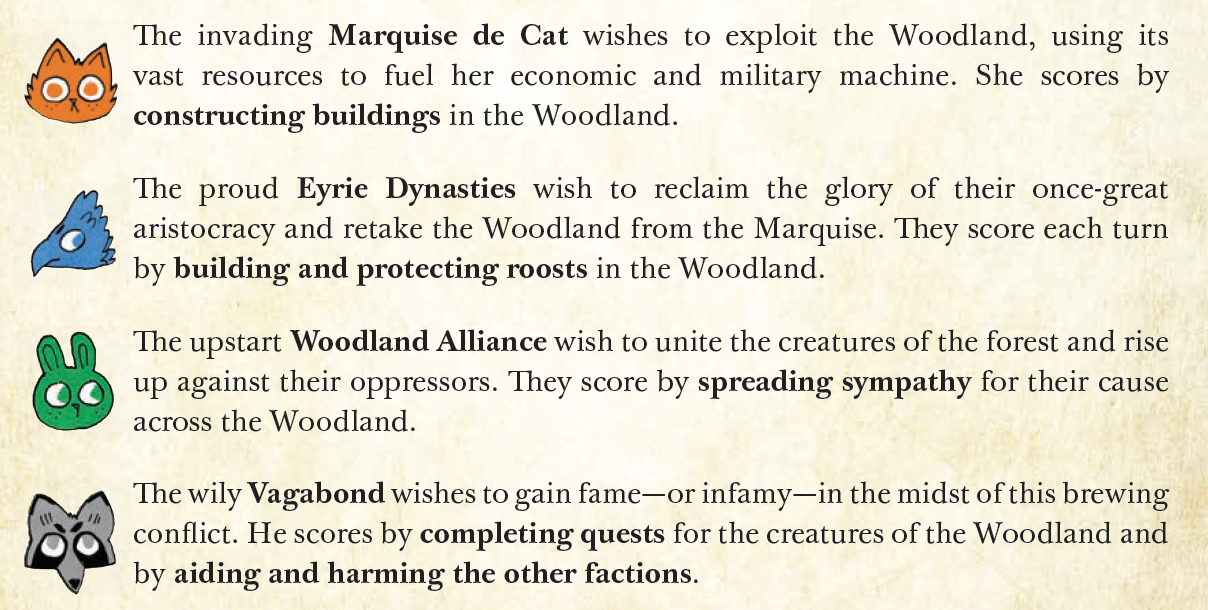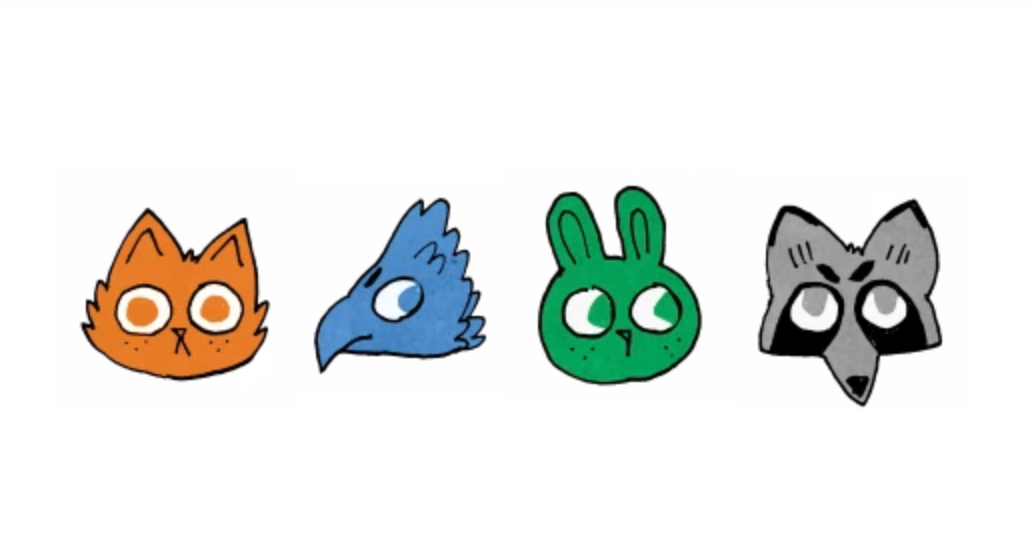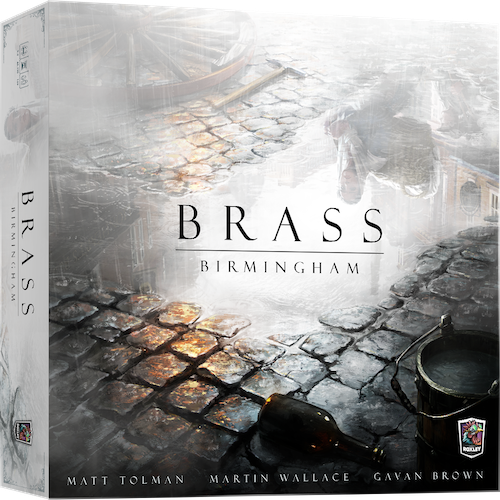Review copy provided by Leder Games.
Asymmetric games are interesting because they usually require a lot more active participation and complex thinking than an ordinary board game. If each person is doing something different, then every player has to focus on their own game. They can’t copy someone else’s strategy and if they can’t devise an effective plan, then winning is unlikely.
For some, that’s a barrier for entry. It forces everyone to focus and to learn an entirely unique playstyle. And asymmetric games usually take longer. But if you’re willing to accept some of those conditions, or if you’re already familiar with the game in question and that doesn’t bother you, then you can discover some truly exceptional gaming experiences.
It can be exciting to have powers and play conditions that no one else has. There is a gleeful pleasure in performing some action and having another player exclaim, “You can do what?!”
And with every character, faction, or playable group being different, it elevates the replayability of a game by making the game new every time a player chooses something to play they haven’t tried before. Other players will also use the factions or characters in novel ways and with strategies that the game group hasn’t seen yet.
All of that brings us to Root, the game of “woodland might and right” from Leder Games. Designed by Cole Wehrle, with stunning art from Kyle Ferrin, it’s a board game that has won the hearts of many tabletop gamers since its 2018 release.
Late last year, I reviewed Vast: The Mysterious Manor, another asymmetrical adventure from Leder Games, but it had some drawbacks that I thought would trip up a lot of players.
Root, however, feels like it doesn’t slip in the same areas, despite its early release date.
Let’s look at the game in detail and examine why it’s so popular and what gamers might enjoy from the woodland wargame.
STORY
The nefarious Marquise de Cat has seized the great woodland, intent on harvesting its riches. Under her rule, the many creatures of the forest have banded together. This Alliance will seek to strengthen its resources and subvert the rule of Cats. In this effort, the Alliance may enlist the help of the wandering Vagabonds who are able to move through the more dangerous woodland paths. Though some may sympathize with the Alliance’s hopes and dreams, these wanderers are old enough to remember the great birds of prey who once controlled the woods.
Meanwhile, at the edge of the region, the proud, squabbling Eyrie have found a new commander who they hope will lead their faction to resume their ancient birthright. The stage is set for a contest that will decide the fate of the great woodland. It is up to the players to decide which group will ultimately take root.
If a forest erupts into war, does it make a sound?
Maybe. Not a big one. Just a sinister mew. Or a baleful squawk. Even a muted pitter-patter. And a sly scurry. It depends on who’s playing and what’s happening.
Each faction in Root has its own role to play. But the story will be up to the players and how they struggle for control in the contested woodlands.
GAMEPLAY
There are four main factions in Root. The feline Marquise is a captain of industry and victory depends on developing an efficient infrastructure. The avian empire gains momentum by growing the population and expanding its territory. The small units of woodland critters survive and thrive through guerrilla warfare and coordinated strikes. And finally, the solitary adventurer balances relationships between the other factions, pivoting between allies and foes.
Leder Games has also published three different expansions for the game that introduce new factions for expanded gameplay—The Riverfolk, The Clockwork, and The Underworld expansions.
So if these four aren’t enough for you or if you play frequently and want to enliven the game, those are also options.
But it’s enough to just consider the four base factions for now.
Play evolves over the course of three phases for each faction’s turn—Birdsong, Daylight, and Evening. Each faction board has different actions available during these phases. The Marquise de Cat might perform a lot of crafting and actions during Daylight hours. The Eyrie Dynasties might spend several minutes planning their Decree in the Birdsong phase. And the Woodland Alliance could prepare for a powerful next turn during the Evening when the officers perform military operations.
Each faction will score Victory Points (VPs) according to the actions that are tied to their strategy. Roosts are pivotal to the Eyrie. Quests and items are the lifeblood of the Vagabond. And so on.
There are two ways to win the game. A player needs to reach 30 VPs or play and complete a dominance card. Each method proves difficult, as other players will be competing in the same space and when one player pulls away from the rest, it will likely result in a painful flurry of attacks in the woods.
In the early games of Root, there is an airy sense of freedom in not having to worry about paying attention during your opponents’ turns. Which allows everyone at the table to talk and enjoy each other’s company. If there are one to three other players that perform turns completely different than yours, it enables you to disengage from the frantic strategizing and plotting. This is a nice aspect of the game.
When you play more, you might spend some time analyzing the other players’ turns, as you likely know the abilities of all the factions and the potential damage or disruption that could occur.
But you also might not!
So there’s a social element to Root, and to other asymmetric games, that I enjoy very much. It might be a longer game. And it might be a complex game. Still, though. You’re able to chat with your friends and fellow gamers. That’s nice.
Root has a lot going on. This means that discussing gameplay can be either excruciating detailed or irritatingly vague. It’s hard to strike the right balance.
I can say, however, that the rulebooks—yes, plural—do a good job of getting players started without drowning them in the law of the land.
One is a reference booklet. It’s designed for those moments when you need an exact understanding of the game. It’s also perfect for those players that prefer text-heavy explanations and a thoroughly-organized database of everything Root. Most players won’t start with this, but whoever explains the game in your group—you know who they are—will need to familiarize themselves with this thicker manual.
The other is the learn-to-play guide, which breaks up the text with illustrated examples, graphics, and a more gradual introduction into the mechanics that define Root. It’s a well-designed rulebook that will help players grasp the essentials without bogging them down in all of the minutiae.
In a lot of the games I play, these two rulebooks are the typical ones included. One to get you started and acquainted with the most important rules. Another to guide future play and to settle any rules misconceptions or conflicts.
Root includes one more little gem, though. An extended example of play that guides four players through two full turns of the game. It’s perfect for those players that dread lengthy rules explanations and for those that need hands-on gameplay. It provides instructions for what to do, what to say to other players, and also answers to questions that players might have as to why they’re supposed to do whatever it is they’re doing.
You may never use this little pamphlet, but it’s a fantastic inclusion that increases accessibility in the game, which is important for more complex games. Any player aid that encourages people to sit down and enjoy the tabletop adventure is welcome.
An exploration of Root is not complete without a look at its art.
VISUALS
Kyle Ferrin created some of the most beautiful tabletop art I’ve ever seen. Root, at its core, is a cutthroat world of woodland skirmishes and territorial control. You would never guess that looking at it. The character design, card art, and overall look of the game are all magical.
The pastel-colored wood pieces. The vibrant landscape of the forest, in fall and winter. The cutesy game tokens.
These are the awards that the game was nominated for during the 2018 Golden Geek Awards:
2018 Golden Geek Board Game of the Year Nominee (Winner)
2018 Golden Geek Best Thematic Board Game Nominee (Winner)
2018 Golden Geek Best Strategy Board Game Nominee
2018 Golden Geek Best Board Game Artwork & Presentation Nominee (Winner)
It won three of the four, but I’m not sure it would have won for the Thematic Board Game or Artwork and Presentation categories without the work of Kyle Ferrin.
His efforts transport you into the woodlands. You’re captivated by the forest. I want to bring Root to the table not just to play but also to look at it and show it off to my friends. That’s when you know an artist has successfully brought to life the imagination of a game designer. Cole Wehrle made something really special here. But Kyle Ferrin made it unforgettable.
REPLAYABILITY
Replay value is high in a game like Root. All four factions are totally unique. Yes, there is a shared deck of cards, but the primary actions and style of each faction guarantee diverse gameplay.
That only increases when you consider the expansions and all of the extra content that’s possible. Those expansions shouldn’t affect how you feel about the base game, but it certainly should encourage any prospective buyers that there is additional content to extend the lifespan of the game.
I’m much more impressed with Root than I was with Vast: The Mysterious Manor. I think it’s better designed, better explained, and it’s just gorgeous to look at. But it’s also more likely to get on the table and stay there. Three expansions and two double-sided playmats ensure that you can have a new experience every time you sit down with the game.
WHAT IT COULD HAVE DONE BETTER
There are some minor aspects of the box design that I wish were different, but Leder Games does better than most in creating an efficient use of space. All of the pieces nestle into small compartments, with the faction boards, game board, and rules all stacked on top to prevent pieces from tumbling around in the box. I’d prefer a little wider or longer box to more easily grab the boards out, but that’s a small concern.
Also, I’d actually like the extended example of play to be longer, with more explanations as to why something is happening. I can’t hold that against Leder Games too much, though, because the game has the rulebook in the first place. That’s not something that most games offer, so the extent to which it’s delivered can’t be faulted too harshly.
I’ve got other things that I would hope for with a game like this—and with the amount of extra content available—but Root avoids a lot of issues from which similar games suffer. It’s a complex asymmetric game that is decently accessible. It’s a big game that delivers big enough thrills to match its scope. And it’s so enthralling from a visual perspective that it draws in gamers like flies to… whatever draws in flies.
VERDICT
Root is a superlative tabletop experience that reflects the highest potential in the genre of asymmetrical games. It’s deserving of all the awards it has won. It features strategy without inscrutable complexity. It features a well-crafted theme without any negative impact on the gameplay. And it features unforgettable art that only serves to enhance the overall experience.
I’d recommend it to any hobbyist gamer and its strengths are enough to compel even hesitant newcomers to the world of tabletop gaming.























